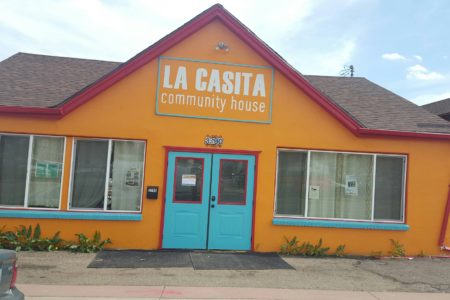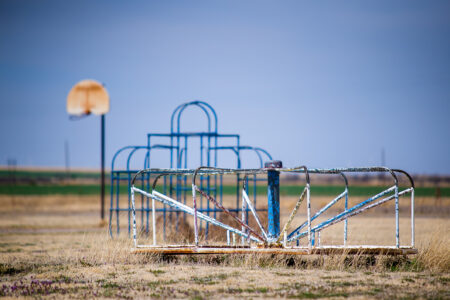Share On Social!
Westwood Unidos and Re:Vision, two local organizations in the Westwood neighborhood of Denver, Colo. (31.2% Latino population) were already working to make the area a healthier place for families.
Westwood Unidos organized local community members, like Fany Mendez, to teach fitness classes in their spare time wherever they could, such as schools, churches, and even bars.
When Westwood Unidos learned about a small building that was going to be torn down on a piece of land recently purchased by Re:Vision, Westwood Unidos raised the money to transform the building into a community center named La Casita, with educational and physical activity classes taught by Mendez and local community members.
Westwood Families Not Active Enough
Fany Mendez, before she became the Coordinator of La Casita for Westwood Unidos, had worked as a certified nursing assistant (CNA) at Broomfield Skilled Nursing and Rehabilitation. Westwood Unidos is a coalition of residents working with organizations to improve health in the Westwood neighborhood.
She made the switch from the clinical to the community setting because she wanted to address health at the community level to reach all families in her Westwood neighborhood.
Mendez knew that people who aren’t physically active are at higher risk for many chronic illnesses such as heart disease, stroke, diabetes, and some forms of cancer. However, Westwood lacked safe places to walk, bike, and play, as well as sources of nutritious food.
In her spare time, she taught fitness classes at local churches, shops, and bars. However, she knew that there had to be a better location so that everyone could participate.
“We realized that these spaces weren’t appropriate for the community, especially for families where some kids were brought to the bars, as well,” Mendez said. “The cleanliness was also a factor, where we would do our best to clean, but the floors were still sticky and just not appropriate.”
In 2011, 31.4% of Colorado children were overweight or obese, up from 28.4% in 2004.
Disparities in childhood overweight and obesity rates burden Latinos and other minority children more than whites, largely due to a lack of access to safe places to play and be physically active, like parks and recreation centers.
The Westwood neighborhood has the least amount of park acreage in all of Denver; it was severely lacking safe, accessible facilities for community members to participate in physical activities. Moreover, Westwood was divided by Morrison Road, an unsafe, auto-oriented street. Families on one side of the Morrison Road could not easily access businesses on the other side and would not let their children cross to get to the park on the other side. This limited residents’ access to community resources and was a major barrier in their participation in physical activity.

Mendez thought the lack of safe places to play was concerning because Westwood is a low-income neighborhood with a very large child (39.14% of the population under 18 years of age). There is also a large Latino (80.93%) population, compared to Denver County with 21.07% of the population under 18 years of age and 31.2% Latino.
Approximately 44.97% of Westwood children live in poverty compared to 27.67% in Denver County, and 25% do not speak English.
Creating a safe, accessible place for families to come together and be physically active soon became high on everyone’s list.
In 2013, the Colorado Health Foundation awarded Westwood Unidos and fiscal agent Re:Vision International a $1 million, three-year Healthy Places grant to improve the built environment and increase physical activity levels.

In addition to three primary grant projects to improve the build environment, the grant sparked the community to think deeply about the question: “Qué es su sueño para una comunidad saludable?” or “What is your dream for a healthy community?”
Mendez dreamed of developing an educational center to serve as a central hub for socializing, learning, and being physically active.
Other community members wanted a place to exercise, learn and socialize, too, Mendez said.
But how could they get such a place?
Finding a Safe, Accessible Space for Families
Joseph Teipel and Eric Kornacki, officials with Re:Vision International, were already thinking about a place to connect community members with each other and with healthy resources. They wanted to create a food co-op, and they had a specific site in mind.
For years, they had been eyeing a dilapidated 1.7-acre piece of property on Morrison Road; however, it was not on the market and not for sale. They had even contacted the land owner many times, but he wasn’t interested in selling.

In early 2014, city of Denver Office of Economic Development (OED) approached Re:Vision and offered them money if they could buy the property they had been eyeing before the end of the year. Through the allocation of the city’s federal Community Development Block Grant funds, the OED offered financing through a performance-based grant with the stipulation that Re:Vision provides food access to residents for at least 20 years.
“That lit a fire under us,” Teipel said.
In order to demonstrate community benefit, Re:Vision conducted a feasibility assessment on their food co-op and determined it will “create 30 local jobs for the community; generate $2.5 million in annual revenue to sustain operations; enable 20,000 residents to increase access to affordable and healthy foods; and provide 1,000+ co-op members ownership of the food hub.”
“Our goal is to create livable communities,” said Denver Mayor Michael B. Hancock. “Healthy neighborhoods where we can walk, bike and play; where fresh foods are as accessible as jobs, healthcare and education. By leveraging city dollars in partnership with the private sector, we are spurring meaningful development for our residents in the Westwood neighborhood.”
After a roller-coaster nine months, Re:Vision finally was able to enter into a contract with the landowner and with the city.
The city of Denver Department of Environmental Health conducted an assessment and the property acquisition deal, and provided Re:Vision with a $1.2 million performance-based loan to buy the property.
They closed on the property at the end of September 2014. The previous owner had 90 days to relocate, and Re:Vision took ownership on January 1, 2015.
Holistic Community Development
The property had multiple buildings on site and Re:Vision was considering how to activate the whole property in a holistic community development sense, in addition to the food co-op.
 They quickly learned they didn’t have capacity to run and operate programming in all of the space.
They quickly learned they didn’t have capacity to run and operate programming in all of the space.
“It was a significant amount of work to get the property cleaned up,” Teipel said. “We had to abate asbestos, clean up a lot of junk and trash, and tear down one of the warehouses.”
One building in particular, which was used to store taxidermy supplies, was being considered for demolition.
“Our initial site plan showed it being demolished and taken off the map,” Teipel said.
Because Re:Vision and Westwood Unidos, as well as other community members and organizations were already working together to make Westwood a healthier neighborhood, word spread about this building that was up for demolition.
During the time Re:Vision was cleaning the property, Kornacki suggested alternative uses for the to-be-demolished building, like an educational center run by Westwood Unidos.
“After some structural assessments, it was obvious that it was decent structure,” Teipel said.
They knew it would need a lot of work before it could be opened for public use. However, Re:Vision wasn’t in a place to invest money into other projects at the time.
Partnering for Community and Health
Mendez and Westwood Unidos didn’t want to miss an opportunity for such a centrally located educational center near a food co-op on Morrison Road, which recently was scheduled for pedestrian-safety and traffic-calming improvements—through the Healthy Places grant—after years of uninhibited vehicular traffic growth.
They considered the implications of the combined positive effects of improved pedestrian safety with a building for an educational center and exercise classes where residents could to socialize, learn, and participate in physical activity.
Rachel Cleaves, coordinator for Westwood Unidos, Teipel, and Kornacki began discussing leasing options for the building.

Cleaves asked Re:Vision: If Westwood Unidos raised the funds to renovate the building, would Re:Vision credit that amount toward rent?
It was obvious that the community needed a place for exercise classes, Teipel said. The idea fell under their umbrella of connecting community members to each other and to healthy resources. They hadn’t done anything like this before, but they were interested.
Re:Vision estimated the costs for restoration as well as short- and long-term rent.
In 2015, Re:Vision and Westwood Unidos entered into a 10-year leasing contract for the building for rent to be 50% of the market rate if Westwood Unidos paid for renovations immediately.
Re:Vision also agreed to credit rent for the amount of money that Westwood Unidos put into the renovations.
La Casita Serves Community

It took a year of fundraising for Westwood Unidos to complete the renovations for the building, now called “La Casita” or “The Little House.”
Westwood Unidos members were the first ones who volunteered their time to help with cleaning and providing building materials. For example, community members provided yoga mats and a stereo system and a local business donated the flooring.
La Casita opened on March 2, 2016 with numerous physical activity classes in Spanish, such as yoga, Zumba, and aerobics, as well as GED and children’s music classes in Spanish for $2 – $4 or less.
“On March 2, we had our inauguration,” Mendez said. “It was an amazing event. The mayor was there, city councilmen, and the press.”
Providing a centrally located, safe, and affordable place for community members to learn and play, particularly when programming is family-friendly and in Spanish, is an excellent way to reduce inequity in access to active spaces among Latinos.

Because Westwood Unidos invested $60,000, Westwood Unidos will not start paying rent until around 2025, which will be 50% market value, Teipel said.
Mendez is thrilled to have a safe, clean space to teach fitness classes, which due to thoroughfare improvements to Morrison Road, will soon be even more accessible for families. She and Westwood Unidos are now looking into partnerships and funding opportunities to maintain their various programs at low or no cost to residents.
“I am proud of this wonderful facility you are opening today,” Hancock said. “The Westwood community has worked so hard to make today possible. Westwood Unidos has now brought healthy opportunities closer to home, this is now the crown jewel in the crown of the Westwood community.”
Learn more about Healthy Places Initiatives going on Westwood and watch Colorado Health Foundation videos here.
References
1. U.S. Census Bureau. (2008). American Community Survey (ACS). 2009-2013. U.S. Department of Commerce, Washington, DC. Available.
2. U.S. Census Bureau. (2012). County Business Patterns. (CBP). 2013. U.S. Department of Commerce, Washington, DC. Available.1
3. U.S. Department of Agriculture, Economic Research Service, USDA – Food Access Research Atlas (FARA). (2010). U.S. Department of Agriculture, Washington, DC. Available.1
4. Centers for Disease Control and Prevention (CDC), National Center for Chronic Disease Prevention and Health Promotion (NCCDPHP). 2012. Atlanta, GA. Available.1
5. Centers for Disease Control and Prevention (CDC), Behavioral Risk Factor Surveillance System (BRFSS). 2005-09. Atlanta, GA. Available.1
6. U.S. Department of Health and Human Services, Health Resources and Services Administration, Area Health Resource File (AHRF). 2012. Washington, DC. Available.
By The Numbers
33
percent
of Latinos live within walking distance (<1 mile) of a park
This success story was produced by Salud America! with support from the Robert Wood Johnson Foundation.
The stories are intended for educational and informative purposes. References to specific policymakers, individuals, schools, policies, or companies have been included solely to advance these purposes and do not constitute an endorsement, sponsorship, or recommendation. Stories are based on and told by real community members and are the opinions and views of the individuals whose stories are told. Organization and activities described were not supported by Salud America! or the Robert Wood Johnson Foundation and do not necessarily represent the views of Salud America! or the Robert Wood Johnson Foundation.



